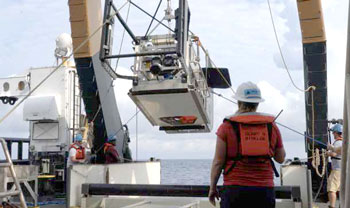Deep-See: A New Tool for
Ocean Exploration

Deep-See being recovered to FSV Henry B. Bigelow after its first deployment.
NOAA Press Release—Northeast Fisheries Science Center and Woods Hole Oceanographic Institution researchers partnered to develop and test a new instrument called Deep-See. We will use this 2,000 pound, 20-foot long instrument will explore an area of the open ocean just off the edge of the continental shelf known as the Twilight Zone, where light from the surface stops penetrating. Deep-See was built with a grant to WHOI from the National Science Foundation, and the Northeast Fisheries Science Center helped develop the project and provided the ship-time for the testing and evaluation.
The Twilight Zone, also called the mesopelagic zone, ranges from about 200 to 1,000 meters (about 660 to 3,300 feet) in depth. Because of its extreme depth, little is known about this area.
Deep-See is an acoustic, optic, oceanographic, and biological sampling system that uses wideband echosounders, stereo and holographic cameras, environmental and light sensors, and eDNA instruments. The Deep-See platform collects data at unprecedented rates and sends real-time information back to the surface for researchers to see and monitor.
During August, the first test cruise to evaluate the new platform took place aboard NOAA’s ship Henry B. Bigelow. Researchers wanted to see how all the instruments and sensors worked together and adapted to pressure under water at the depth of the Twilight Zone. The researchers also trawled for fish and other marine life. Elusive beaked whales and other whale species studied by Center scientists are known to dive to these depths.
Deep-See’s many instruments and sensors communicate with the Bigelow through a 4,000 meter (roughly 3,000 foot) 0.681-inch fiber optic cable. The Henry B. Bigelow is the first NOAA Fisheries research vessel to have this fiber optic technology aboard, which greatly expands its capabilities for scientific monitoring and research.
For more information, contact Michael Jech at the Northeast Fisheries Science Center at 508-495-2353 or email Michael.jech@noaa.gov
